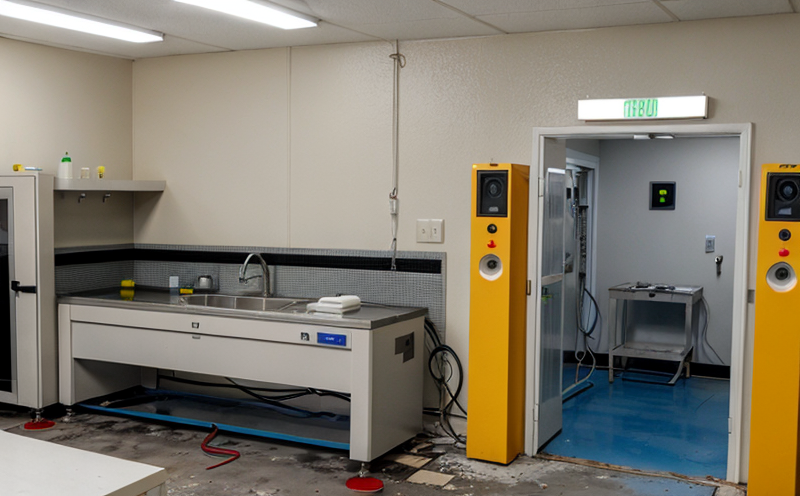ASTM D7282 Surface Contamination Monitoring of Soils
The ASTM D7282 standard method is a critical tool in surface contamination monitoring and is widely used by environmental, nuclear, and industrial sectors to ensure compliance with regulatory requirements. This method provides a standardized procedure for measuring the total beta particle and photon-emitting surface contamination on non-fibrous, planar, solid surfaces.
ASTM D7282 involves the use of a portable surface contamination meter equipped with a low-energy window Geiger-Mueller detector. The instrument is capable of detecting alpha, beta particles, and photons emitted from the surface being tested. This method ensures accurate measurement by providing detailed instructions on specimen preparation, calibration procedures, and data interpretation.
The ASTM D7282 procedure is designed to be used in a wide range of environments, including industrial facilities, nuclear power plants, and laboratories dealing with radioactive materials. The primary goal of this standard is to provide a reliable method for detecting and quantifying surface contamination on solid surfaces such as floors, walls, equipment, and personnel protective clothing.
The testing process begins with careful preparation of the specimen. The surface being tested should be free from dust and debris to ensure accurate readings. Once prepared, the surface is scanned using an ASTM D7282-compliant instrument. The scanner moves over the surface in a systematic pattern, collecting data at various points.
The collected data are then analyzed according to ASTM D7282 criteria. The standard provides detailed instructions on how to interpret the results and determine whether the contamination levels exceed acceptable limits. If the contamination is found to be above the specified threshold, further investigation or corrective actions may be necessary.
ASTM D7282 ensures high-quality testing by adhering to strict calibration procedures and using instruments that meet international standards such as ISO 17025. This method provides a robust framework for surface contamination monitoring, ensuring consistent and reliable results across different environments and applications.
- Calibration: Regular calibration of the detection instrument is crucial to maintain accuracy. ASTM D7282 specifies procedures for calibrating instruments using reference materials that meet ISO 17025 standards.
- Data Interpretation: The standard provides guidelines on how to interpret the data collected during testing, ensuring consistent and accurate results.
- Environmental Factors: ASTM D7282 accounts for environmental factors such as air humidity and temperature that can affect test results. Proper adjustments are made to account for these variables.
The use of ASTM D7282 ensures that surface contamination monitoring is performed with high-quality standards, providing reliable data that meets regulatory requirements. This method is essential in maintaining safety and compliance in environments where radioactive materials are present.
Eurolab Advantages
At Eurolab, we pride ourselves on offering comprehensive services that meet the highest industry standards. Our expertise in ASTM D7282 surface contamination monitoring of soils ensures that our clients receive accurate and reliable results every time.
- International Expertise: With a team of highly qualified professionals, Eurolab brings extensive experience and knowledge to each project.
- State-of-the-Art Equipment: Our laboratory is equipped with the latest instruments that adhere to international standards, ensuring precise measurements and accurate data.
- Compliance: We ensure our processes comply with all relevant regulations, providing peace of mind for our clients.
- Rapid Turnaround: Eurolab prides itself on delivering results quickly without compromising quality.
- Custom Solutions: Tailored services to meet the specific needs of each client, ensuring no two projects are identical.
Choosing Eurolab for your ASTM D7282 surface contamination monitoring needs means partnering with a reputable and reliable service provider. Our commitment to quality ensures that you receive accurate results every time.
Quality and Reliability Assurance
- Calibration: Regular calibration of the detection instrument is crucial to maintain accuracy. ASTM D7282 specifies procedures for calibrating instruments using reference materials that meet ISO 17025 standards.
- Data Interpretation: The standard provides guidelines on how to interpret the data collected during testing, ensuring consistent and accurate results.
- Environmental Factors: ASTM D7282 accounts for environmental factors such as air humidity and temperature that can affect test results. Proper adjustments are made to account for these variables.
- Instrument Validation: Instruments used in ASTM D7282 testing undergo rigorous validation processes to ensure they meet the required performance specifications.
- Data Accuracy: Eurolab uses advanced data processing techniques to ensure that all results are accurate and reliable.
- Traceability: All test data can be traced back to the original samples and calibration standards, ensuring transparency and accountability.
At Eurolab, we take quality and reliability assurance very seriously. Our commitment to excellence ensures that every ASTM D7282 surface contamination monitoring project is conducted with precision and accuracy.
Use Cases and Application Examples
The ASTM D7282 method finds application in numerous sectors, including environmental protection, nuclear power plants, industrial facilities, and laboratories dealing with radioactive materials. Below are some specific use cases where this standard is particularly relevant:
- Nuclear Power Plant Decommissioning: During the decommissioning process of a nuclear power plant, it is essential to ensure that all surfaces are free from radioactive contamination. ASTM D7282 provides a reliable method for detecting and quantifying surface contamination.
- Industrial Facilities: Industrial facilities that handle radioactive materials must regularly monitor their surfaces to ensure compliance with regulatory requirements. ASTM D7282 offers a standardized approach to this task.
- Laboratories: Laboratories dealing with radioactive substances need to maintain strict contamination control measures. The ASTM D7282 method is an essential tool for achieving this goal.
In all these applications, the ASTM D7282 method provides a reliable and standardized approach to surface contamination monitoring, ensuring that surfaces are free from radioactive contaminants.





